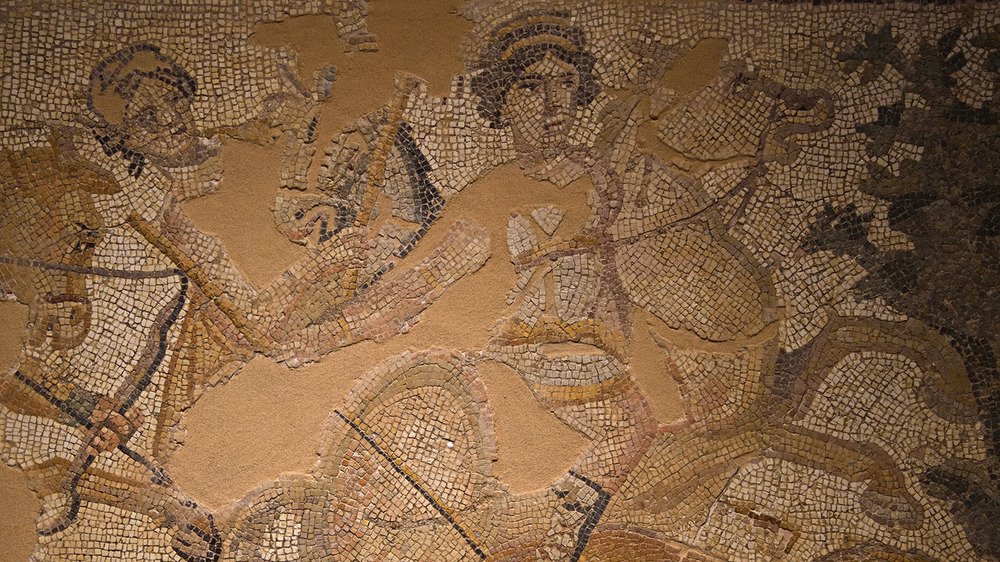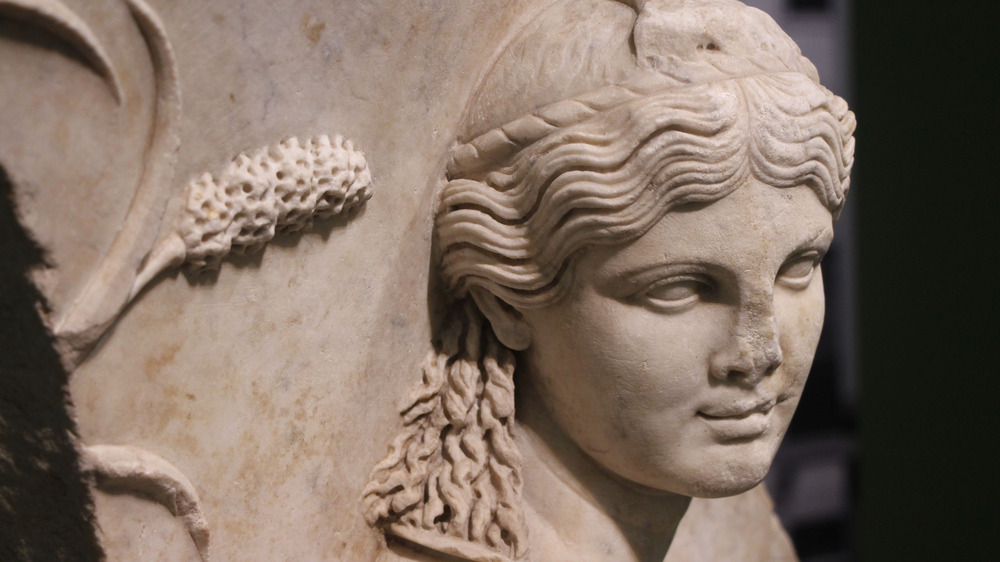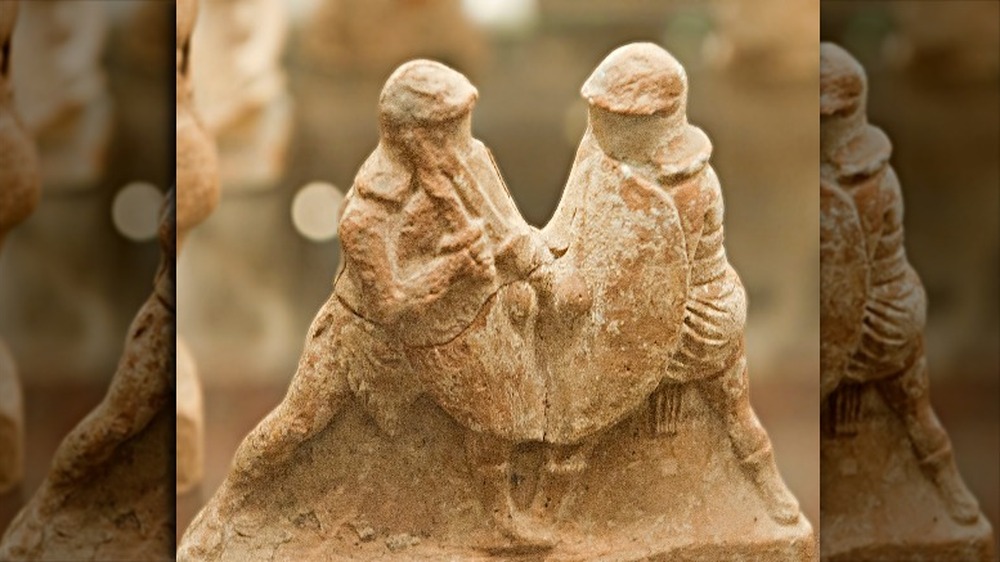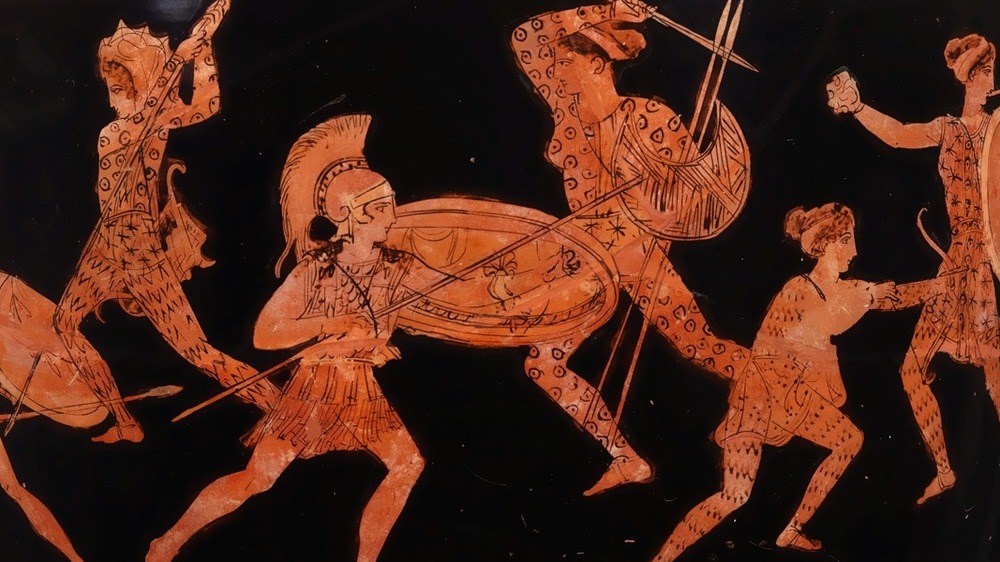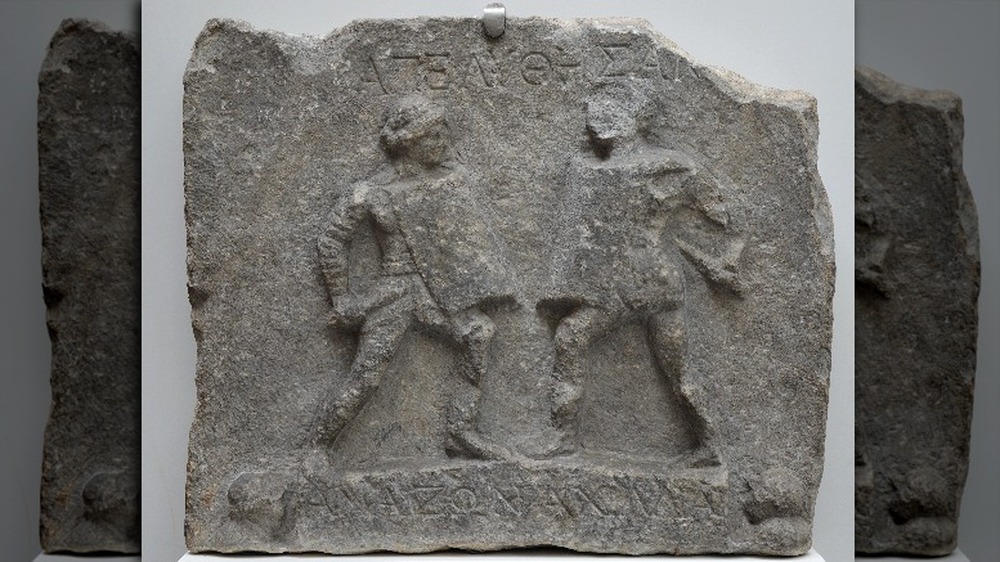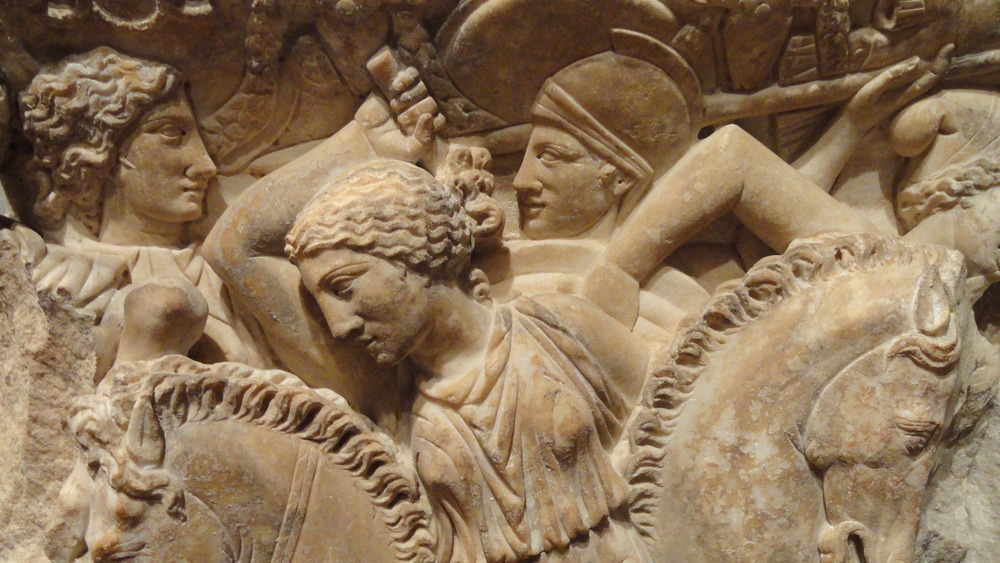The Truth About Female Gladiators In Ancient Rome
Gladiators are a pretty famous part of ancient Rome nowadays, thanks to a series of exciting features, documentaries, and at least one or two Hollywood blockbusters following the exploits of these ancient sports heroes. Surely, it's easy enough to imagine one right now. You're probably thinking of a brawny, muscular man, perhaps wearing a helmet and wielding a sword as he faces off against his opponent in the ring. A potentate watches from the ancient Roman equivalent of a box seat, while the rest of the crowd clamors all around the gladiators. Perhaps there's a dramatic defeat, wherein everyone waits with bated breath as the game's sponsor decides whether or not the downed gladiator should be allowed to live.
Now, there's quite a lot about this scene that's historically accurate, from the eager crowd to the one-on-one gladiatorial matches that entertained them. Yet, there are some significant changes that can still be made in the interest of historical accuracy. For starters, let's take that hyper masculine brawler out of the picture and replace him with a woman.
Yes, a woman. As it turns out, female gladiators were a documented thing in ancient Rome. While they may not have been as ubiquitous as their male counterparts, female gladiators clearly made an impression on Romans, from awed spectators to panicked conservative commentators. In the millennia between them and us, however, plenty of myths have arisen. Here's the truth about female gladiators in ancient Rome and beyond.
Female gladiators were rare, but they definitely existed
For quite a long time, you might be forgiven for thinking that female gladiators were no more than a wild fiction. Gladiators, after all, are known to have lived flashy, oftentimes violent lives flexing before cheering crowds. That was hardly expected for Roman women, who were told to be diligent and demure. Sure, except for the fact that, as the Ancient History Encyclopedia points out, many of the writers talking about women were men, and often conservative men at that. The real roles of women in ancient Rome were pretty varied — and that extends to the gladiatorial arena, too.
Though the evidence for them may not be as abundant as it is for male gladiators, we can now be sure that female gladiators existed. According to the Ancient History Encyclopedia, we've uncovered a wide variety of evidence about them, from carvings showing their battles, to alarmist legislation barring certain women from taking part.
They would have probably been called ludia (female entertainers or, in some sources, the girlfriends of male gladiators) or mulieres (women). They are almost never referred to as feminae (ladies), as that would have been usually reserved for higher-class women, who only very occasionally might have been in the arena. Meanwhile, words like gladiatrix or gladiatrices, cool as they are, would have sounded pretty odd to ancient Roman ears. Those terms are purely modern inventions that first pop up in the 19th century.
Ancient writers documented female gladiators
Ancient Roman writers occasionally mentioned female gladiators, oftentimes to act out their shock that people weren't sticking to good, old-fashioned Roman values. Their misogyny and conservatism sometimes make it difficult to tell what other Romans might have thought of women in gladiatorial combat, but they at least confirm that female gladiators were occasionally a real spectacle.
Juvenal, who wrote in the 1st and 2nd centuries CE, was especially aghast at seeing female gladiators, says the Ancient History Encyclopedia. "What sense of shame can be found in a woman wearing a helmet, who shuns femininity and loves brute force," he wrote, then going on to describe what, to him, must have been the ludicrous idea of a wife or girlfriend selling off her gladiatorial gear.
A few decades later, fellow chronicler Cassius Dio wrote that the sight of gladiatorial women "was at once most disgraceful and most shocking," not least because he reportedly witnessed highborn women cavorting about in the arena.
Roman women of different classes became gladiators
Though it appears that more lower-class than upper-class women became gladiators, there's some evidence that even women from high ranks performed and fought in the arena. Cassius Dio wrote that women of as high as the senatorial order were to be found there. "They drove horses, killed wild beasts, and fought as gladiators, some willingly and some sore against their will," he reported.
That last line is especially interesting, in that it gives us a hint as to how some of the women involved became gladiators in the first place. Some of the female gladiators were likely freeborn, but others were very probably slaves who fought because they were forced to. The Journal of Combative Sport says that, if we assume female gladiators went by more or less the same rules as their male counterparts, then some would have been "voluntary slaves" who relinquished their freedom, most likely for financial gain.
Ironically enough, the appearance of female gladiators in an arena may have meant that a game's sponsor was especially lavish and generous, as The Classical World reports. Women fighting appears to have been a special kind of treat for the audience. That link between female gladiators and decadent sponsors may have also contributed to the shocked commentary penned by Cassius Dio and his fellow writers. It's especially ironic given that gladiators were often seen as lower class, while their sponsors were the ones depicted as hurrying along the degeneration of Rome.
Rome passed laws restricting female gladiators
Some of the best evidence for the existence of female gladiators is the indisputable fact that Roman politicians legislated against them. Rome as a whole tended to get pretty uncomfortable whenever women tried to step outside of their set gender roles, which generally revolved around being an unobtrusive wife and mother and fading quietly into obscurity. But, with such a large and diverse population, there's no doubt that quite a few women simply couldn't force themselves into that mold. And that, apparently, made Rome nervous.
As per the Ancient History Encyclopedia, the Roman Senate first passed laws concerning female gladiators in 11 CE. In that year, freeborn women younger than 20 were barred from taking part in any entertainments in the arena.
Later, in 200 CE, Emperor Septimius Severus officially forbade any woman from gladiatorial combat or other arena-based shows. Cassius Dio wrote that it was because even upper class women were taking part in the game, "with the result that jokes were made about other very distinguished women as well. Therefore it was henceforth forbidden for any woman, no matter what her origin, to fight in single combat" (via University of Chicago). Yet, it appears that some women ignored the emperor's pearl-clutching decree, since they're recorded as engaging in gladiatorial combat as late as the 3rd century CE.
It wasn't easy being a gladiator
Regardless of gender, gladiators had a tough road to travel. Sure, some found fame and glory, like the many gladiators whose names are still known to us today, says History Extra. Those include Spartacus, who led a slave revolt in the 1st century CE, along with other notables like Flamma, Attilius, and Commodus, the Roman emperor who occasionally jumped into the ring himself.
Yet, for all of the famous gladiators, many more broke their bodies in the arena or even died for a crowd's entertainment. According to History Extra, they would have fought in heavy, restrictive armor (when they got armor, anyway), in a world where relatively unadvanced medical care meant that injuries could become life-threatening infections if you survived even that long. Still, they at least enjoyed good medical care for the time, though that could involve setting broken arms and amputating limbs with little or no anesthesia.
Excavations of gladiator burials in Ephesus also showed that the great majority of them were seemingly healthy men who died in their twenties, indicating that their careers are what killed them in their prime of life. Quite a few appear to have died of single, deadly injuries likely incurred in the arena.
Female gladiators really did have to fight
Though we can be pretty confident that women fought as gladiators in some context in ancient Rome, it's still difficult to get a full picture of their lives. After all, as The Classical World explains, ancient Rome did not have a dedicated term for "female gladiator," meaning that writers had to twist their accounts into lengthy explanations to make things clear. Luckily, from a historical standpoint, this also meant that some writers described the kinds of things women did as gladiators. This includes accounts of them fighting with weapons and armor.
It's possible that female gladiators would have fought in a very similar style to that of their male counterparts. According to the Ancient History Encyclopedia, gladiators typically fought as one of four types of fighter: the Murmillo, with a crested helmet; the Retiarius, who sported a net and often a trident; the Samnite, with a visored helmet; and the Thracian, who carried a curved weapon. All except the Retiarius carried a form of shield as well. Often, different types of gladiators were pitted against one another, with the assumption that their weapons were complementary and would make for a good show.
Female gladiators had a mythical and literary precedent
While some Romans had trouble accepting the idea of women in gladiatorial combat, no one could rightfully argue that there wasn't a precedent for the spectacle. Stories of ferocious female warriors, like the Amazons, likely helped some Romans to accept the idea of women in gladiatorial combat.
Some female gladiators even appear to have taken stage names inspired by these stories. A stone carving uncovered in Halicarnassus, now in modern Turkey, shows two female gladiators who were clearly drawing on the literary models established in earlier legends. According to Forbes, one of the women in the carving is identified as "Achillia" and, more simply and directly "Amazon." Achillia appears to be a feminized version of Achilles, a legendary Greek hero who, perhaps not coincidentally for the gladiators, fought an Amazon queen named Penthesilea.
There was a somewhat darker, more exploitative side to this mythical sense of Amazonian gladiators. The BBC reports that some female gladiators appear to have fought topless, much like the Amazons were said to have done. While it was clearly linked to legend, this practice also underlies the ways in which Roman society exploited and sexualized female performers like these gladiators, likely without regard for what the women themselves may have wanted.
Roman art provides clear evidence that women were gladiators
While someone might interpret the literary evidence for female gladiators as a bit of an overdramatic protest over something that probably didn't happen all that often, this position gets more difficult to support when you consider all of the visual evidence for female gladiators.
As per the British Museum, one stone relief found in modern day Turkey shows two gladiators whose stage names were Achillia and Amazon. The carving appears to mark the occasion of an especially fateful fight where both gladiators were spared from death or even released entirely from service — one assumes after a bout that was judged especially entertaining and honorable by the game's sponsor and the crowd.
Another piece of visual evidence has been the subject of debate for generations. National Geographic reports that the object, a small bronze statuette made around the 1st century CE, depicts a half-nude woman bearing an object. Originally, researchers thought the object was a strigil, a cleaning tool used by Romans to scrape oil and dirt off their bodies. However, some argue that the object is actually a curved sword known as a sica, which was wielded by gladiators in particular. Given that the figure hefting it aloft has some clearly female characteristics, this would be compelling evidence for another artwork showing a female gladiator.
There's evidence that female gladiators traveled outside of Rome
Gladiators of any gender weren't only confined to the capital city of Rome. There's very clear evidence that arenas were built throughout Roman territory and that gladiators and other performers were making appearances wherever they would be paid. Female gladiators, though they appear to have been an unusual feature of many games, also clearly traveled throughout the Roman empire.
According to Unroman Romans, one damaged inscription clearly indicates that women fought in the port city of Ostia, a relatively short distance away from Rome today, but a trip that would have taken more effort in ancient times. Worn as it is, the fragmentary Latin that survives boasts about how a local official was the first to host games with female gladiators, apparently a notable enough achievement to be marked in stone.
There's also the relief of two female gladiators found at Halicarnassus, a city that's now in modern day Turkey (via British Museum). That's admittedly not definitive evidence that the two women shown in the carving fought in the Roman city there, but it's certainly a compelling clue that at least the notion of female gladiators wouldn't have been utterly shocking even on the edges of the empire. Meanwhile, the remains of the Great Dover Street woman suggest that they made it as far as the Roman colony of Britannia, as Discover argues.
One possible female gladiator's burial was uncovered in modern Britain
Excavators working in modern day London uncovered an ancient Roman burial from the 1st century and, as a result, touched off a modern-day debate about female gladiators. According to Discover magazine, the excavators actually found an entire graveyard, but it was a single burial that drew the most attention. The burial contained the partially cremated remains of a woman and lay on the perimeter of the cemetery.
Eventually known as the Great Dover Street woman, this person was given a costly burial with not only valuable grave goods left behind in the grave, but the remains of what appears to have been a lavish and certainly expensive feast held in her honor. Those grave goods proved to be especially interesting for modern archaeologists and historians.
As Gladiatrix reports, no other Roman grave of this era in Britain really compares. The Great Dover Street woman was buried with things from all over the empire, including lamps that bear the image of Anubis, the Egyptian god who was often said to escort the dead on to the afterlife. Most intriguing, one lamp shows a fallen gladiator, which many have interpreted as a direct reference to this woman's profession. It's a controversial assumption for some, but compelling for many other. The Great Dover Street woman certainly seems to have been respected and pushed to the margins in equal measure, much like gladiators of her time.
Becoming a female gladiator likely meant taking a step away from Roman society
Because they were so far outside the norm for Roman women, it's likely that female gladiators who survived to retire had complicated lives out of the arena. They were simultaneously serious warriors and also entertainers who were ogled by audience members, occupying a confusing and tenuous place in structure-obsessed Roman society. As the journal Chronika asserts, Roman women were typically expected to live out one of only a very few different lives, most of which focused on marriage and motherhood.
Of course, the real stories of Roman women are more complicated, but contemporary writers and politicians indicate that there was a societal expectation in place nonetheless. Either way, life as a gladiator was a pretty significant departure from this track, which is perhaps why lower-class women appear to have been more likely to take up fighting in the arena, in part because they had less to lose.
Some sources state that women who entered the arena may have given up their chance to marry, according to History Collection. This would have been a dramatic turn indeed in a Roman woman's life. It could be that a female gladiator would have been inextricably associated with low class people like entertainers and sex workers. Even if a particular gladiator stuck only to arena combat in her professional life, this may have been enough to devastate her chance at marriage and a family if she survived to retire.
Unlike other games, female gladiators weren't a joke
While the Romans weren't above belittling others for entertainment purposes, it appears that many took the rare female gladiators pretty seriously. According to A Companion to Sport and Spectacle in Greek and Roman Antiquity, the novelty of women in the arena did not necessarily put them in the same class as other, less respected entertainments. Contrast that to some acts that were clearly meant to make audiences laugh, like pushing people with dwarfism to fight one another.
Women would have trained hard for their battles, attending gladiatorial schools like their male compatriots and wielding very real weapons in their bouts, as the Ancient History Encyclopedia reports. All of the evidence for the very existence of female gladiators, from statues and carvings celebrating their accomplishments, to the diatribes that decry Roman interest in the practice, shows that the unusual woman in the gladiatorial arena was typically at least as respected as the male gladiators who fought there, too.

